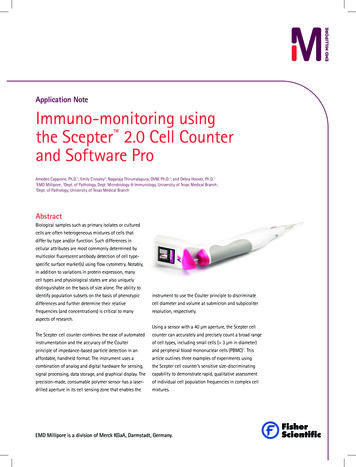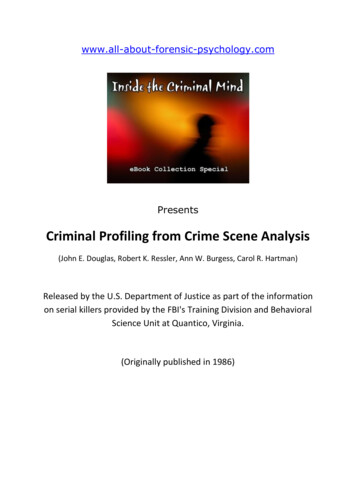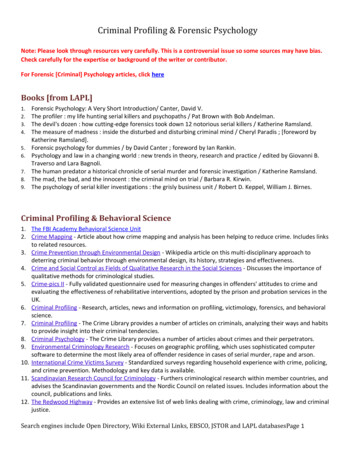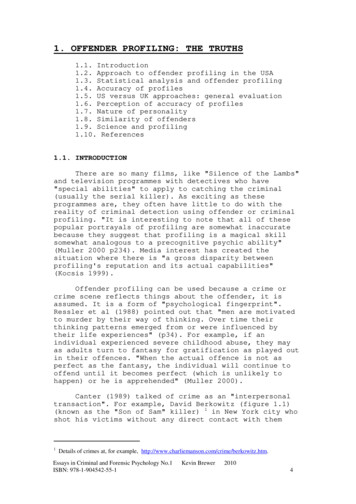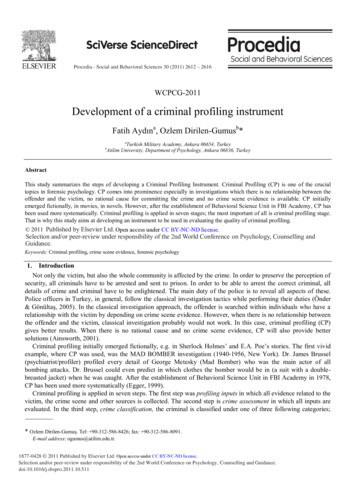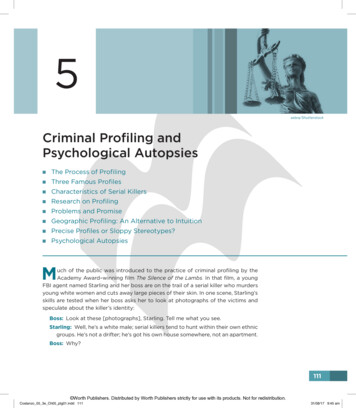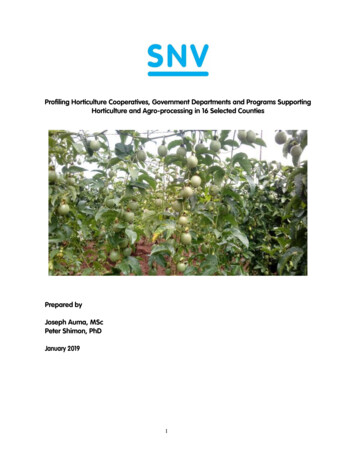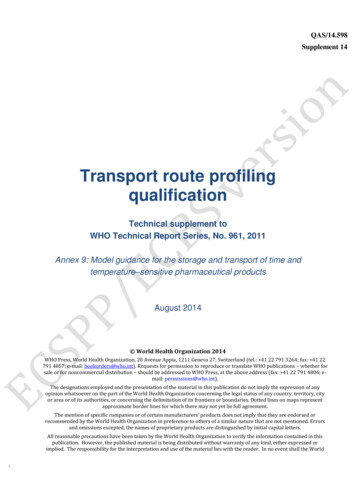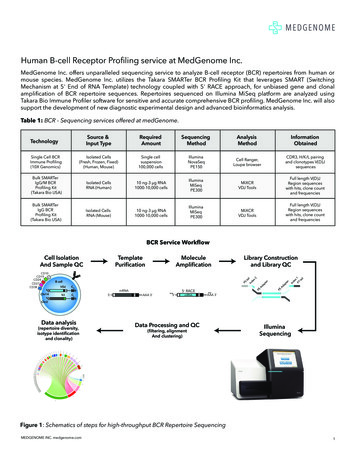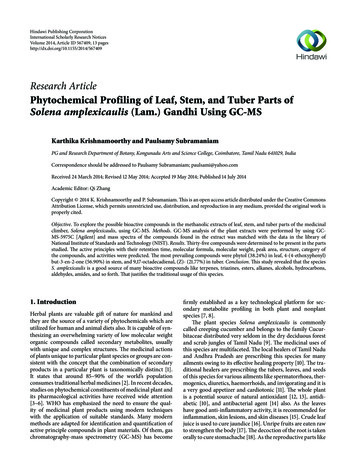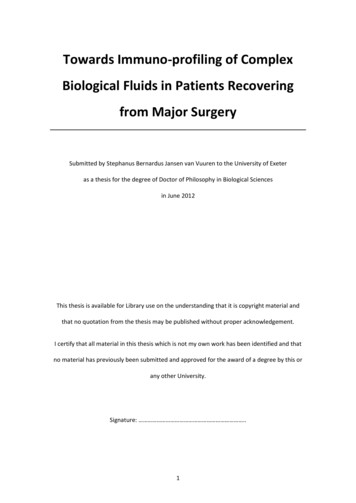
Transcription
Towards Immuno-profiling of ComplexBiological Fluids in Patients Recoveringfrom Major SurgerySubmitted by Stephanus Bernardus Jansen van Vuuren to the University of Exeteras a thesis for the degree of Doctor of Philosophy in Biological Sciencesin June 2012This thesis is available for Library use on the understanding that it is copyright material andthat no quotation from the thesis may be published without proper acknowledgement.I certify that all material in this thesis which is not my own work has been identified and thatno material has previously been submitted and approved for the award of a degree by this orany other University.Signature: .1
2
DankieMa, Pa, Sussie en Dan3
4
AbstractThe conventional biochemical diagnosis of disease using isolated blood biomarkers must berevisited by clinicians, replacing it with a multi-biomarker, personalised profile of humanhealth. A label-free nanoparticle array technology, Liscar, has been developed. It is capable ofperforming rapid, multi-biomarker assays from complex biological samples which, if employedto assay the Complement cascade of the innate immune system, has the potential for a novelsystemic profile of patient health.An assay for IgG has been developed on the Liscar platform with a detection limit of 380 100 ng/mL IgG in model sera. Furthermore, addition of a chaotropic agent to the complexsample is shown to improve the accuracy of the IgG assay. Competitive binding betweennonspecific interfering proteins and specific target analytes (IgG) at the sensor surface isstudied, and a quantitative mathematical model is developed to analyse the data, yieldingevidence for the active displacement of albumin by IgG-antigen binding.With a sensitive, accurate multi-biomarker detection platform, a systemic profile of patienthealth may be possible by examination of the Complement cascade. The Complement systemcan be activated by a variety of immunological challenges, causing large numbers of activationbiomarkers to be produced quickly. Assays for three activation markers, C3d, TCC and Bb aredeveloped, with detection limits of 0.864 ACS Units, 2.32 ng/ml and 54.7 ng/ml respectively.Complement activation was tested in a prospective cohort study of 45 patients undergoingmajor abdominal surgery. Patient recovery was monitored from admission to 60 hourspostoperatively by Complement activation and consumption using C3d, TCC, Bb, C3 and C4 asbiomarkers. A response profile was obtained for the entire cohort for C3 and C4 assays bynormalising with respect to individual analyte levels on admission, against which individualresponses are compared. 22% of patients in the study suffered postoperative complications,and 73% showed Complement activation by increased levels of C3d, as expected from theinitial trauma of surgery. Expansion of the trial is needed to establish clinical significance andutility, especially in relation to the presymptomatic diagnosis of disease.5
6
Acknowledgements, sincerelyI would like to thank my supervisor, Professor Andrew Shaw, as well as Dr Rouslan Olkhov,Dr Robert Parker and Dr Maxim Rooth for their continuous guidance and support throughoutmy PhD. This could in no way ever have been possible without you. Specific acknowledgementmust go to Rouslan for writing the computer program used in Chapter 3 of this thesis, howeverhe also deserves extra special thanks for his saint-like patience and willingness to explain thesame things over and over, and over again. Thanks also to Tom Read and Lyndsey Penwill fortheir unrelenting joyfulness around the lab. Thank you also to Professor Paul Morgan, Dr ClaireHarris and Dr Lana Hakobyan – you were exceptionally helpful on everything Complement.Thank you very much, Dr Yvonne Clements, for your help with the MSD instrument, and a hugethank you to all the staff at the RD&E Hospital who were so exceptionally helpful witheverything during the CPOP trial.Thanks very much to Dr Nick Walker for sticking out another 4 years at Exeter with me.I’d also like to thank a number of people who have excelled in their roles as ‘moral supporters’throughout the last four years. It is only because of their never-ending supply of cheer andencouragement that I have been able to get this far. I thank you from the very bottom of myheart. You are all wonderful people.Tommy England, Michael Taylor, Rich Smith, James Seckel, Steve Humphrey.Elly Mills, Anna Johns, Josh Stokes, Beth Durkin, Louise Parkin and Ben Hayes.Emily Timmins, Aaron Summons, Jonny Eccles, Matthew Cuss, Faye Rodwell, Katie Carter, AlexBramley, Gareth Campbell, Claire Lincoln, Libby Wilding, Becky Fox, Emma O’Hare and Nikki.7
8
Table of ContentsTable of Abbreviations . 15Table of Figures . 17Table of Tables . 24Chapter 1 . 251.1Biomarker Detection Techniques . 311.1.1Label-Free Biosensors . 311.1.2Chemically Labelled Biosensors . 351.1.3Other Labelled Detection Techniques . 371.2Handling Complex Biological Samples. 371.2.1Surface Chemistry Development. 381.2.2Sample Preparation Protocols. 391.2.3Kinetic Analysis of Label-free, Protein-Protein Binding Studies . 401.3Detecting Biomarkers in Clinical Samples: Monitoring Biological Systems . 401.3.1The Complement System . 421.4Assessing Biomarkers for Diagnosis . 471.5Aims and Objectives . 50Chapter 2 . 532.1Introduction . 532.1.1Nonspecific binding . 572.1.2The Vroman Effect. 579
2.1.3Surface Control Proteins . 582.1.4Reducing Nonspecific Binding . 582.1.5Protein Separation . 592.1.6Protein Separation – Choatropes . 602.1.7Aims and Objectives . 612.2Method . 612.2.1Experimental . 622.2.2Chemicals . 652.2.3Sensor Surface Preparation . 652.2.4aBSA-BSA Binding Experiments . 662.3Results . 662.4Discussion . 692.5Conclusion . 78Chapter 3 . 813.1Introduction . 813.1.1Aims and Objectives . 833.2The Binding Models . 843.3Materials and Methods . 863.3.1Chemicals . 883.3.2Sensor Surface Preparation . 883.3.3Experiment List . 883.4Results . 8910
3.5Discussion . 923.5.1High Affinity Binding (aBSA-BSA binding only) . 933.5.2Low Affinity HSA-BSA Binding . 973.5.3Competitive Binding: HSA interference with aBSA-BSA binding . 1003.5.4The Overall Global Fit – Competitive Binding Model . 1023.6Conclusions . 109Chapter 4 . 1114.1Introduction . 1114.1.1Previous Complement Activation Studies . 1134.1.2Aims and Objectives . 1154.1.3Proposed Complement Activation Study . 1154.1.4Differential Complement activation monitoring . 1164.1.5in vitro Complement Activation . 1184.2Target Activation Fragments . 1184.2.1Bb Fragment . 1194.2.2C3d Fragment . 1214.2.3C4d Fragment . 1234.2.4The Terminal Complement Complex (TCC) . 1234.2.5Fragment-Specific Antibody Assays – Neoepitopes . 1244.3Assay Method . 1274.3.14.4Electrochemiluminescence Assays . 127Methods: Complement Activation Assay Development - TCC, Bb, C3d and C4d . 12811
4.4.1Protocol for in vitro serum Complement Activation . 1284.4.2Polyclonal Secondary Antibody Assays . 1294.4.3SULFO-TAG labelled monoclonal antibody assays . 1314.4.4Labelling Detection Antibodies with MSD SULFO-TAG NHS Ester . 1334.4.5Assay Optimisation, Calibration and Controls. 1334.5Results . 1344.5.1Secondary Antibody Assays. 1354.5.2Tagged monoclonal assay development – TCC, Bb and C3d . 1364.5.3Activated Complement Serum (ACS) Calibration– TCC and Bb Calibration . 1384.5.4in vitro C activation assessment using Zymosan and HAIGG . 1404.6Discussion . 1434.7Conclusion . 153Chapter 5 . 1555.1Introduction . 1555.2CPOP Trial Pro
I would like to thank my supervisor, Professor Andrew Shaw, as well as Dr Rouslan Olkhov, Dr Robert Parker and Dr Maxim Rooth for their continuous guidance and support throughout my PhD. This could in no way ever have been possible without you. Specific acknowledgement
